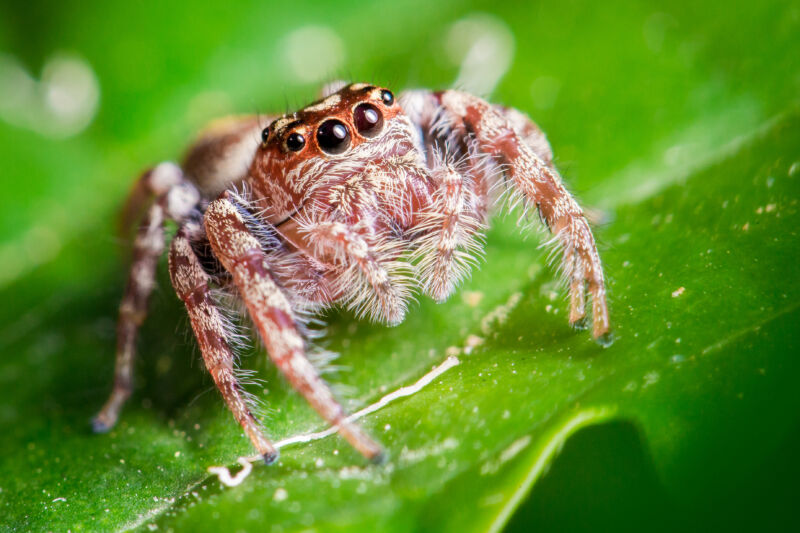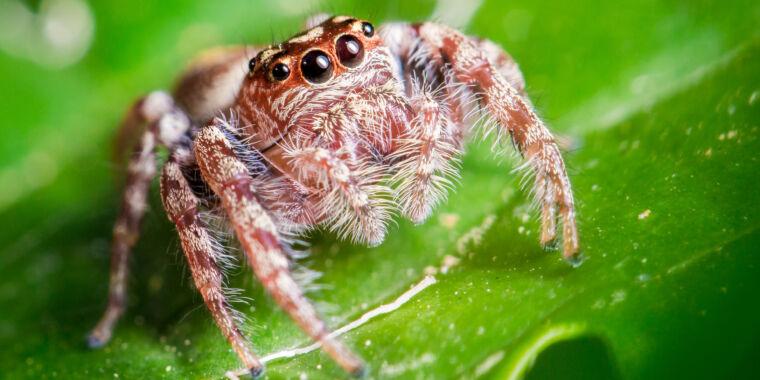
Our sleep is marked by cycles of distinct brain activity. The most well-known of these is probably rapid eye movement, or REM sleep, which is characterized by loss of muscle control leading to twitching and paralysis, along with its eponymous eye movements. REM sleep is widespread in vertebrates, appearing in many mammals and birds; similar periods have also been observed in lizards.
Figuring out what might be going on beyond vertebrates can get a bit challenging, however, as identifying what constitutes sleep isn’t always clear, and many animals don’t have eyes that move in the same way as those of vertebrates. (Flies, for example, must move their entire head to reorient their eyes.) But an international team of researchers identified a group of jumping spiders that can reorient internal portions of their eyes during what appears to be sleep.
And according to this team, the spiders experience all the hallmarks of REM sleep, with periods of rapid eye movements associated with muscle twitching.
Spider napping
Spiders, and specifically jumping spiders, may have more going on mentally than might be assumed based on their tiny size and correspondingly tiny nervous system. But the key to this new study was the discovery that, apparently, they sometimes just need a nap. A year ago, some of the same team members were authors of a publication that reported sleep-like behavior in these spiders. At night, they’d find some overhanging vegetation, attach a single thread to it so they could dangle from it, and then stay there until light returns in the morning. By all appearances, they’re sleeping.
And that gives the researchers a chance to avoid one of the bigger challenges in cross-species sleep studies. The eyes of jumping spiders contain structures called retinal tubes, which can be moved to direct the spider’s vision to specific locations. These tubes aren’t visible in adult spiders due to the pigment in the spider’s cuticle. But newly hatched spiders take some time to develop that pigment, having translucent bodies that allow the movements of the retinal tubes to be tracked.
And so the researchers decided this was the perfect opportunity to see whether spiders might have an REM-like phase to their overnight rests. “The most salient indicator of REM sleep is the movement of eyes during this phase,” they write. “Movable eyes, however, have evolved only in a limited number of lineages—an adaptation notably absent in insects and most terrestrial arthropods—restricting cross-species comparisons.” For these jumping spiders, that restriction doesn’t apply.
So, they shut the lab lights off, let the spiders enter their sleep-like state, and then tracked any movement using an infrared camera.
Are rapid eye movements REM?
Just as you might see in a mammal, the spiders experienced periodic periods of rapid eye movement—albeit involving the movement of retinal tubes. Although these events varied a bit from instance to instance and between individuals, they generally lasted similar amounts of time, and they repeated with a period that was similarly consistent.
Perhaps more significantly, the retinal tube movements were frequently associated with twitching or curling of the spiders’ legs. Only about 40 percent of the periods of eye movement were associated with leg twitching, but every leg twitching that happened over the sleep period was associated with eye movement.
It’s not clear that this behavior represents REM because it performs the same function as REM sleep does in humans (something we’re still working to understand). But physically, the hallmarks seem to be there, which has some significant implications. “That these characteristic REM sleep-like behaviors exist in a highly visual, long-diverged lineage further challenges our understanding of this sleep state,” the researchers note. This is especially true given that other researchers have published findings of REM-like behavior in distantly related animals like cuttlefish.
But the spiders at issue here provide a distinct possibility of testing how deep the parallels go. People have proposed that the eye movements of REM are a product of replaying visual memories during sleep. In a lab environment, it’s possible to expose these spiders to visual stimuli that force them to perform specific patterns of eye movements. After which, you can shut the lights off and see whether the same pattern is repeated during sleep.
PNAS, 2022. DOI: 10.1073/pnas.2204754119 (About DOIs).








